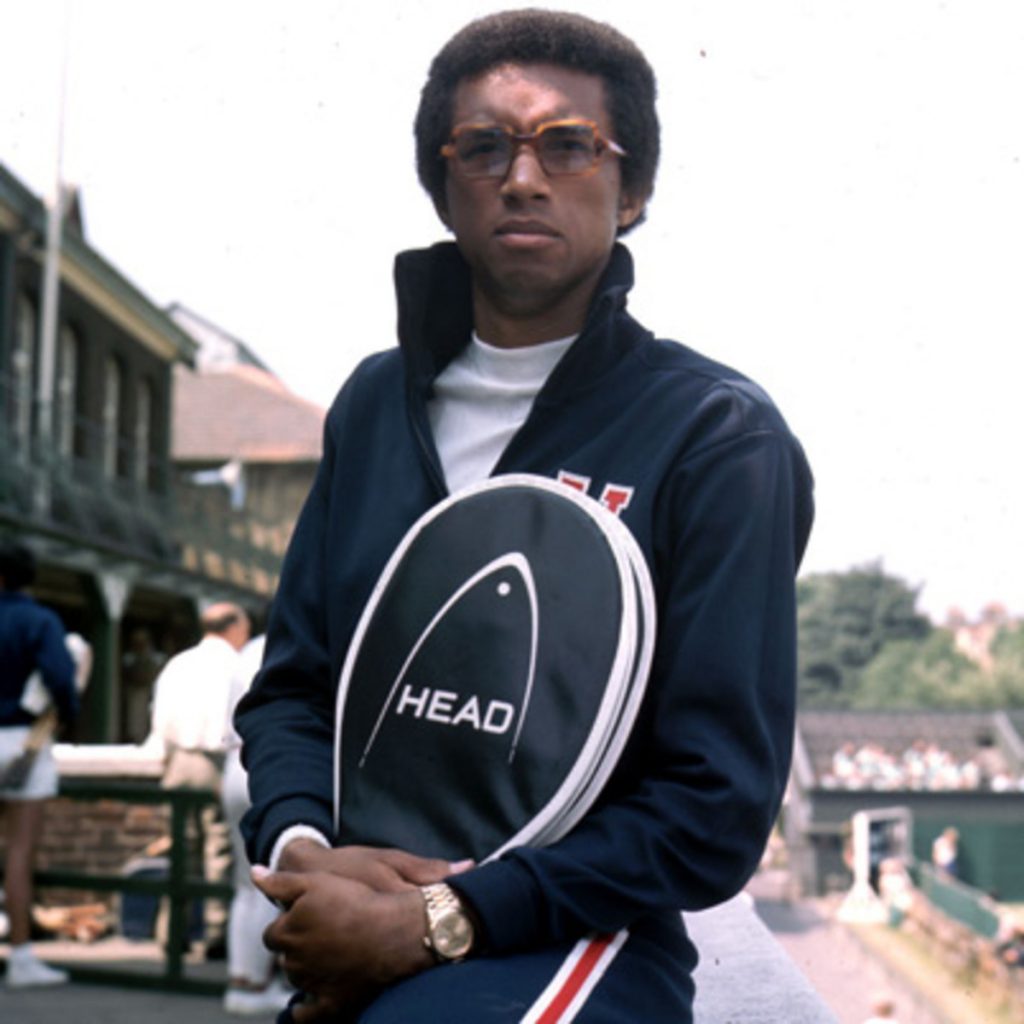Arthur Robert Ashe Jr. was born on July 10, 1943 in Richmond, Virginia. Growing up, he didn’t have the “ideal childhood.” At the age of five, his mother died from a toxemic pregnancy, which was hard for him and his family. Ashe and his siblings were raised by their father after this tragedy.1
Ashe’s father wanted for him to excel in sports. In the neighborhood he grew up in, football was the popular sport, and very popular for many African-American children. Arthur saw playing football as an outlet for dealing with the pain of his mothers’ death. He wanted to play football, but his father forbade him. His father felt that he wasn’t big enough to take action in football and was given the childhood nicknames “Skinny” or “Bones.” Arthur stressed to his father how badly he wanted to play, but the idea was continuously shut down.2
At the age of seven, Ashe found his passion for playing tennis. Every day, he would go to the tennis courts and practice from sun up to sun down. Ron Charity, the greatest African-American tennis player at the time, saw something unique in Arthur. He offered to help Ashe fine tune his game and turn him into a championship tennis player. Throughout his journey, he faced many injustices regarding his race.3

In 1973, Ashe was the first African-American tennis player to be invited to the South African Open Championship. During this time, the South African laws, known as Apartheid, separated people by culture and race. South Africa was trying to use the invitation to Arthur Ashe as a way to change its racist image in the world. Ashe agreed to play in South Africa, but only on his terms. He used this to his advantage to increase public awareness of South African racism. Following this event, Arthur Ashe played against Ilie Nastase in the Masters tennis games in Stockholm, Sweden. This match in 1975 did not go as planned. Nastase, known in tennis circles as a clown, regularly pushed the limits of players’ and officials’ patience. During his match with Ashe, he often took too much time in between serves, even after being warned. Nastase often teased his opponents on court, which he did to Ashe that day. Although Ashe and Nastase usually got along with each other, that day Ashe wasn’t willing to put up with teasing that verged on insults. Ashe put down his racket and proceeded to walk off the court. He said, “I’ve had enough. I’m at the point where I’m afraid I’ll lose control.” Although Ashe was winning, he couldn’t stand to let another person continuously call him out because of who he was. The official warned him about the consequences if he walked out, but Ashe did not care at that point. He couldn’t stand having to put up with Nastase’s nasty behavior. Late that night, the official committee met and discussed the ruling on the court. The committee knew that if they gave the match to Nastase, they would be supporting his bad, often racist behavior, which was something they did not want to do. In the end, the officials decided that Ashe won purely on the score and skill.4

In 1980, Ashe was forced to retire. Suffering from a severe foot injury plus an intense heart surgery, he found it was too much to handle. Although he did not want to retire, it was a must. Since Ashe left the courts, he assisted in the creation of the Arthur Ashe Stadium in Queens, New York. This stadium is one of the biggest tennis stadiums in the United States. All of the greatest tennis players compete here each year in the US Open.5
In September 1988, Ashe was hospitalized after experiencing paralysis in his right arm. After undergoing brain surgery and a number of tests, doctors discovered that Ashe had toxoplasmosis. This disease paralyzes its victims and is found in people infected with HIV. After undergoing a few more tests, Ashe was then diagnosed HIV positive. The doctors believed he obtained the virus from the blood transfusions he received during his heart surgery. After experiencing these tragedies, Ashe decided to open up a student Health and Wellness Center on the campus of UCLA, which he previously attended.6
On February 6, 1993, Ashe died from AIDS-related pneumonia at the age of 49. He requested to be buried right beside his mother in Richmond, Virginia. He dedicated his whole career to his mother and went down in history as one of the greatest tennis players to live.
- Eric Hall, Arthur Ashe: Tennis and Justice in the Civil Rights Era (Maryland: University Press, 2014), 1-2. ↵
- Eric Hall, Arthur Ashe: Tennis and Justice in the Civil Rights Era (Maryland: University Press, 2014), 4. ↵
- Eric Hall, Arthur Ashe: Tennis and Justice in the Civil Rights Era (Maryland: University Press, 2014), 5. ↵
- Rachel Swarns, “Arthur Ashe and a Victory Unseen,” New York Times, 2000, 7. ↵
- David Wiggins, “Arthur Ashe, Black Athletes, and The Writings of A Hard Road to Glory,” The Journal of African American History no. 4, (2014): 379. ↵
- David Wiggins, “Arthur Ashe, Black Athletes, and The Writings of A Hard Road to Glory,” The Journal of African American History no. 4, (2014): 379. ↵



22 comments
Carlos Sandoval
This was a well written article, I really liked it. It was very easy to remain engaged throughout the whole piece. I did not know who Arthur Ashe was, but it is always good when someone stands up against oppression. This article did a great job of really showing who he was as a person and everything that he represents. However, it sucks to see someone end their career prematurely due to a injury that there was no way of stopping.
Angelica Padilla
Arthur Ashe has an inspiring story to be the first African American to play tennis. He is truly tennis icon and left a legacy. It was his way or no one’s way when competing in matches. It is incredible to hear stories of these people, and realize the bravery and courage it takes for someone to be strong enough to stand up from the negative comments of others who try to put you down. Leaving with with his dignity was more important to him, than letting it get to him.
Didier Cadena
I was unaware of the story of Arthur Ashe, so this article did a great job of explaining who he was. I enjoyed the way in which the story was told, taking key moments from his life, to give the reader a feeling of what a man he was. It was sad to see how his life ended, since it seemed like he had wanted to continue playing for more years to come.
Reese Lujan
I had never heard of Arthur Ashe before this article he broke barriers in the tennis world for all African Americans. He didn’t just take his fame and show it off, he used it as a voice to raise awareness to show support to people just like himself. it is sad that he had to die from such a traumatic illness but his legacy will live on with tennis as well as the Health Center he opened.
Vanessa Tombo
By far one of my favorite article in History media. As an African American who (ranked 1st in singles and 2nd in doubles,) played tennis competitively during my High School years I often faced racism. Though many people claim that we are in the 21 st. century and such things do not occur anymore well they still do. From my opponents not wanting to shake my hand before or after a game or being made fun of by the opponent’s friend because my braids represented an artistic style they did not understand. Overall, I have never connected with an article on this site as I have today. Prior to this article, I had never heard of Arthur Ashe or how he too faced racism while playing tennis and I am deeply grateful to for writing about Ashe and his life story. I have seen today that there are many people who have shared some of my experiences. Finding little pieces of myself in the of another.
Jose Figueroa
It was really great to read about another African-American that fought for equality. Usually Jackie Robinson is the one only talked about but now I can bring Arthur Ashe into light. It was really brave if him to walk off the court knowing there was possible dameges to that game and his career. It was also noble of him to use his platform to bring attention to the apartheid. As tragic as his HIV death, he left a big impact. Great read!
Luis Morales
I never knew of the story of Arthur Ashe. It amazing how despite all the hardships Ashe experienced in his life, he was still able to put all of that aside and still chase after his dreams of becoming a tennis player. It is sad that despite all that Ashe had overcome, he was killed at such a young age by such a terrible disease. This is a true story of inspiration.
Iris Henderson
What a beautiful story! I enjoyed the story of Arthur Ashe and although I am familiar with the stadium in Queens, I did not know his story. It seems that he was standing up to bullying before it was popular by the way he stood up to Nastase. Also, it is tragic that he contracted HIV from a transfusion. I think it is awesome that he turned that into something positive by building the Health and Wellness center.
Kayla Lopez
It amazes me how despite all the adversity and negativity a person experiences in their life, they are still able to put all of that aside and still chase after their dreams. It takes a very mature and self-aware person to be able to walk out of a tennis match, a match you are winning, in order to avoid conflict the way Ashe did.
Edgar Ramon
Why is there not a rule that limits time between serves in tennis, it’s already boring as it is. I am glad that Ashe was given the victory for that match, or game. I would’ve like to hear more about what happened in the South African tournament, with apartheid going on and all, what he had to deal with. Also, it is sad to read how blood given to him in a blood transfusion contained the AIDs virus, it really makes you think about how negligent medical procedures can be.